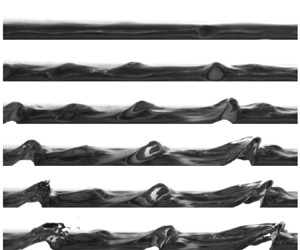No CrossRef data available.
Article contents
On the role of unsteadiness in impulsive-flow-driven shear instabilities: precursors of fragmentation
Published online by Cambridge University Press: 23 October 2023
Abstract

Shear instabilities at the interface of two fluids, such as classical Kelvin–Helmholtz instability (KHI), is the precursor of interface destabilization, leading to fluid fragmentation critical in a wide range of applications. While many insights into such instabilities are derived for steady background forcing flow, unsteady impulse flows are ubiquitous in environmental and physiological processes. Yet, little is understood on how unsteadiness shapes the initial interface amplification necessary for the onset of its topological change enabling subsequent fragmentation. In this combined theoretical, numerical and experimental study, we focus on an air-on-liquid interface exposed to canonical unsteady shear flow profiles. Evolution of the perturbed interface is formulated theoretically as an impulse-driven initial value problem using both linearized potential flow and nonlinear boundary integral methods. We show that the unsteady airflow forcing can amplify the interface's inherent gravity–capillary wave, up to wave-breaking transition, even if the configuration is classically KH stable. For impulses much shorter than the gravity–capillary wave period, it is the cumulative action, akin to total energy, that determines amplification, independent of the details of the impulse profile. However, for longer impulses, the details of the impulse profile become important. In this limit, akin to a resonance, it is the entangled history of the interaction of the forcing, i.e. the impulse, that changes rapidly in amplitude, and the response of the oscillating interface that matters. The insights gained are discussed and experimentally illustrated in the context of interface distortion and destabilization relevant for upper respiratory mucosalivary fluid fragmentation in violent exhalations.
- Type
- JFM Papers
- Information
- Copyright
- © The Author(s), 2023. Published by Cambridge University Press
References
Shen and Bourouiba Supplementary Movie 1
Response of the water-air interface in a cylindrical geometry analogous to a human trachea, to the impulsive shearing airflow impulse profile A given in Figure 20 of the main text. The airflow direction is right-to-left. Transient growth and de-cay of period gravity-capillary surface waves are recorded. No fragmentation occurs throughout the impulse.
Shen and Bourouiba Supplementary Movie 2
Response of the water-air interface in a cylindrical geometry analogous to a human trachea to the impulsive shearing airflow impulse profile B given in Figure 20 of the main text. The airflow direction is right-to-left. Transient growth of period gravity-capillary surface waves leads to surface wave overturn-ing and onset of fragmentation. Onset of droplet formation is visible.





